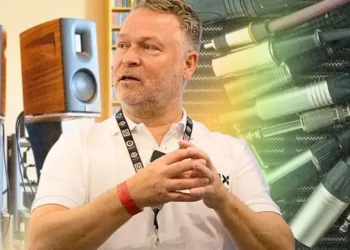Title: Audiophile Blind Test Reveals Surprising Streaming Service Results
Subtitle: $30,000 headphone system fails to deliver consensus among expert engineers
Engineers Blind-Test Streaming Services on $30K Audio Gear — And the Results Were Unexpected
Published: August 5, 2025, 14:00 (U.S. Eastern Time)
A group of professional audio engineers set out to test the sound quality of major music streaming platforms using an ultra-high-end headphone system. But despite the expensive equipment, the results highlighted just how subjective audio perception can be—even among experts.
Blind Test Reveals Split Opinions on Streaming Audio Quality
Three engineers from ABYSS Headphones conducted a blind test of five major streaming services—Spotify, Apple Music, Tidal, Qobuz, and Amazon Music—using a $30,000 headphone setup. Their goal was to objectively compare audio quality by removing brand bias and focusing strictly on listening experience.
To maintain fairness, the team used an external digital-to-analog converter (DAC) capable of displaying real-time resolution. Each engineer brought their own playlist, ensuring a personalized listening experience. However, this approach also led to drastically different rankings, raising questions about how personal taste, familiarity, and mastering differences affect perceived audio quality.
How the Engineers Ranked the Streaming Platforms
Each engineer independently ranked the five platforms based on their blind listening session. Their evaluations produced a wide range of results:
- Joe ranked Tidal first, followed by Qobuz, Apple Music, Spotify, and Amazon Music last.
- Jason placed Apple Music and Amazon Music in a tie for first, followed by Qobuz, Tidal, and Spotify in last place.
- Eric gave the top spot to Tidal, followed by Amazon Music, Apple Music, Spotify, and Qobuz in last place.
This range of results—especially for Qobuz, a service renowned for high-resolution audio—surprised the group. While Tidal performed consistently well, Spotify was ranked at or near the bottom by all three engineers.
Why Did Qobuz Perform Poorly in One Test?
Perhaps the most surprising outcome came from Eric’s rankings, which placed Qobuz, often considered the gold standard among audiophiles, at the very bottom.
Eric had no knowledge of which service was playing during the blind test. At one point, when hearing “Angel” by Sarah McLachlan, he described the audio as “highly compressed” and guessed it might be Spotify. Later, upon hearing a different track he assumed was Qobuz, he noted strange audio effects like a “strobing echo” and wondered aloud whether Atmos processing or some kind of lossy codec was at play.
Once the rankings were revealed and he realized that his least-favored track had come from Qobuz, Eric expressed curiosity rather than disbelief. He questioned whether each service used different versions or masters of the same track—an important but often overlooked variable in audio comparison.
“Do they all have different formats they stream or something? ’Cause they sound slightly different,” he asked during the debrief.
The Mastering Mystery: Not All Hi-Res is Equal
Eric’s confusion points to a key problem in streaming audio quality assessments: mastering inconsistencies. While Qobuz and other platforms may label tracks as “Hi-Res” (e.g., 24-bit/96kHz), that doesn’t mean they’re using the same master.
Some tracks could be loud CD masters, while others might be quiet vinyl rips or dedicated audiophile remasters. Most platforms offer little to no metadata about the specific mastering used, leaving users—and even engineers—in the dark about what they’re actually hearing.
Different Test Strategies, Different Outcomes
Another reason for the conflicting results? Each engineer selected their own playlist for the test. That meant they weren’t comparing the same songs across services—introducing another variable that heavily influenced their rankings.
- Joe, who has decades of experience, used familiar tracks he’s known across various formats (vinyl, CD, high-res digital). He said he could easily tell when something sounded “off” compared to the version he was used to.
- Eric deliberately chose songs he had never heard before to eliminate any personal bias. He wanted to rely entirely on what he heard in the moment, even if that meant unfamiliar sonic details might sway his opinion.
“I wanted the mystery. I wanted to actually compare them for me,” he explained.
- Jason took a middle-ground approach. As a regular Apple Music user, he leaned into familiarity but later acknowledged he might have made different choices with more planning.
This variety in testing methods highlighted how even professional reviews can be influenced by personal habits, preferences, and expectations.
What This Test Says About Streaming Audio Quality
The experiment produced more questions than clear answers—but that was part of the point. Despite using identical hardware and professional-grade equipment, no two engineers came to the same conclusion about which streaming service sounded “best.”
Even Spotify, widely criticized for lower bitrate streaming, managed to beat out Qobuz on at least one track, according to Eric. For example, he noted that a Linkin Park song sounded smoother and less harsh on Spotify, despite its lower technical specifications.
This suggests that perceived audio quality is not solely determined by resolution or format, but also by mastering choices, playback processing, and listener preference.
The Importance of Resolution—And Its Limitations
While the engineers made sure to select the highest available quality settings on each platform, the results showed that resolution alone doesn’t tell the whole story.
“One format might have a higher-res version. Qobuz might have a higher-res version of the same track. But if you’re just searching for a track by name, you could default to the lower-res version,” Jason explained.
Because most platforms don’t clearly indicate which version of a track you’re playing, even a carefully curated test can become inconsistent without full transparency.
Final Thoughts: There’s No One-Size-Fits-All in Streaming Quality
This blind listening session underscored a critical takeaway for audiophiles and casual listeners alike: audio quality is subjective, and streaming platforms are not always easy to compare.
Even with top-tier hardware, engineers with years of experience couldn’t agree on the best-sounding service. Differences in song choice, mastering, familiarity, and format all contributed to a fragmented set of results.
For those seeking the “best” sound, this test is a reminder that it may come down to more than just technical specs. Personal preference, content mastering, and listening context all play significant roles in how we experience digital music.
This article was rewritten by JournosNews.com based on verified reporting from trusted sources. The content has been independently reviewed, fact-checked, and edited for accuracy, neutrality, tone, and global readability in accordance with Google News and AdSense standards.
All opinions, quotes, or statements from contributors, experts, or sourced organizations do not necessarily reflect the views of JournosNews.com. JournosNews.com maintains full editorial independence from any external funders, sponsors, or organizations.
Stay informed with JournosNews.com — your trusted source for verified global reporting and in-depth analysis. Follow us on Google News, BlueSky, and X for real-time updates.












